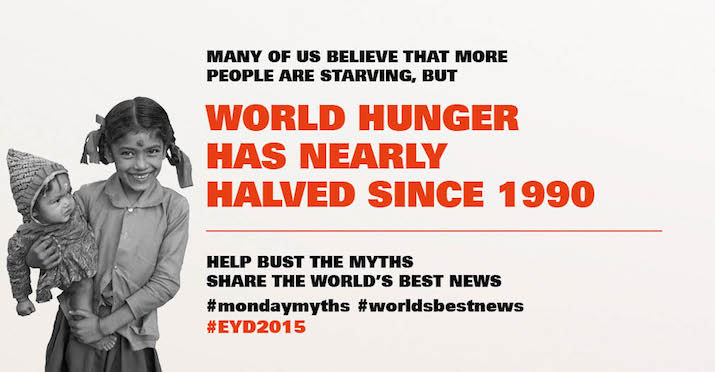
We have nearly halved world hunger
Millions of people have escaped hunger worldwide, though many more still starve. The UN is now seriously planning a future with enough food for everybody. This goal will need political determination and climate action.
Share
Warmer climate can cause hunger
Global climate change is already going on, making it harder to grow food crops. The Intergovernmental Panel on Climate Change (IPCC) predicts lower yields from basic staples such as maize, wheat and rice, if the average global temperature increases by more than two degrees celcius.
If the temperature increases even more, it will pose a very big risk to food security, especially in the tropics. However, it may be possible to adapt to some of the change. The IPCC notes in its latest report that ‘a range of potential adaptation options exist across all food system activities, not just in food production’.
In December this year, world leaders will meet in Paris to try to agree on how to keep the world temperature from rising by more than two degrees.
Monday Myths
World’s Best News is on a mission. We want to bust some of the most stubborn myths about developing countries that many of us believe in and spread.
For example, only 11 percent of Danes know that nine in ten children in developing regions attend school, and 67 percent do not believe that we are seeing progress in the fight against poverty – even though the proportion of extreme poor has in fact been halved globally.
We risk that such myths hold back world development, and therefore it is important to clear them up.
Other categories
“Do you think that we will some day manage to eliminate most of the hunger and poverty in the world?” This was one of the questions asked by World’s Best News in a 2014 survey of Danish opinion on development aid.
Only 14 percent of Danes responded that they believed this vision could be achieved. But there has in fact already been made substantial progress, and today, world hunger has been cut down to nearly half of what it used to be in 1990.
Millions have escaped hunger
In the beginning of the 90’s, nearly one in four people in the developing countries was chronically undernourished. This amounts to more than a billion people, according to the UN Food and Agricultural Organisation (FAO). Today, the number has dropped to 805 million, which means that there are now 209 million fewer chronically undernourished people in the world, when compared to 1990. There is some uncertainty regarding the exact numbers, since there is a lack of quality data from some developing countries, but the scale of the UN figures suggest that more than 23,000 people have escaped hunger every single day for the last 24 years.
This drop in hunger has happened even though the world population has increased by two billion people in the same timespan. Not only are fewer people going hungry, but hunger itself has become a relatively much smaller problem, compared to the size of humanity as a whole.
In 1990, 23.6 percent of people in the developing regions were undernourished, but in 2011, the percentage had dropped to 14.3. Especially Asia and Latin America have been leading the charge against hunger, while Sub-Saharan Africa has seen smaller progress. The numbers for 2015 are not yet in, but the UN has estimated that there are presently around 11.8 percent undernourished people in the developing world. Hunger numbers are expected to continue to drop in the future.
Less need for food aid
The decline in hunger is also reflected in the amount of food aid being sent out. The UN World Food Programme (WFP) fights hunger globally, and their deliveries of food peaked in 1993. In that year, WFP shipped 16.9 million tonnes of supplies to countries with hunger problems. Since then, supplies have been steadily decreasing. In 2012, WFP delivered 4.7 million tonnes.
“We deliver less food because fewer people are starving, and because we now increasingly provide money and food coupons instead of physical food,” says Anne Poulsen, director of the WFP’s Nordic office in Copenhagen. She explains that it often makes better sense to deliver the aid as cash and electronic vouchers (e-cards), because it allows starving people to buy their own food in their local area. In this way, WFP fights hunger while supporting the development of local farms and businesses.
Enough food for everybody
Some people think that it is useless to fight hunger, because they assume that more food means more children, causing overpopulation and starvation. But in fact, the world’s population is growing at an ever slower rate, even though more people now have enough food. Global population growth peaked in the seventies, and has been declining since. The UN predicts that the world population will only grow at half the rate in the coming five years, compared to the period from 1965 to 1970. Eventually, world population is expected to stop growing completely, stabilising at a level of around 10 billion people.
And there is enough food in the world for everybody, according to professor Per Pinstrup-Andersen, an internationally recognised agricultural economist specialised in hunger and poverty reduction in the developing world.
“There is a lot of misinformation out there. No, we are not running out of food. No, we are not going to starve. There are enough resources in the world to feed future generations, even the 10 billion [people] we are going to be by the year 2100,” said Pinstrup-Andersen in a talk at Cornell University in 2012.
End of hunger in 2025?
Halving poverty and hunger before 2015 was one of the eight Millennium Goals agreed by the nations of the world almost 15 years ago. As we now approach the deadline, most of these goals have either been reached, or real progress has been made. The goal to halve world hunger was almost reached, even though not all countries and regions have seen the same amount of change.
But it is not enough that we are now half way to eradicating hunger, according to the UN. In September this year, world leaders will meet again, this time to agree on a new set of goals to be reached before 2030. One of the new goals will likely be to eliminate world hunger entirely. To achieve this, strengthening agriculture in the developing countries will be key. FAO believes the goal is realistic, but that it will take ‘sustained political commitment at the highest level’.
If the political will is present, then the world might be able to eventually harvest more than just crops. The battle against hunger is not just a question of helping other people to have a better life for their own sake. FAO believes that solving hunger problems will also make a major contribution to poverty reduction and to global peace and stability.







